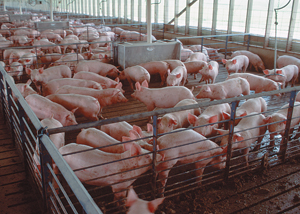
Features
Applications
Swine
New studies are providing insight on soil sustainability
April 28, 2008 by Manure Manager
How do repeated swine manure applications affect crop production, soil and environmental quality over time?

|
How do repeated swine manure applications affect crop production, soil and environmental quality over time?
A new study funded by Saskatchewan Agriculture and Food’s Agriculture Development Fund provides some encouraging news. Results show that manure applied at agronomic rates—meaning that the rate of application is in balance with crop nutrient requirements and removal over time—is a sustainable management practice.
Dr Jeff Schoenau of the Department of Soil Science at the University of Saskatchewan is the lead scientist on the research project. “Our intent was to develop guidelines and recommendations as to how the nutrients and organic matter in manures are best utilized in an agronomic and environmentally sustainable manner,” says Schoenau. “We have in place four long-term manure research trial sites across Saskatchewan where we are looking at different rates, sequences and methods of application of manure.”
The scientists measure soil properties like nutrient content, organic matter, soil structure, crop yield and quality. Teams worked mostly with hog manure, but also with cattle manure.
“We found that when manure is applied at agronomic recommended rates—which may be accomplished by manure testing and soil testing to determine the appropriate rate and balance of manure and fertilizer nutrients to meet the crop demand—we see no evidence of nutrient loading or any negative effect on the quality of the soil.”
There is a caveat to this finding, however, according to Schoenau: “We do see evidence of nutrient build-up, increased losses by leeching or denitrification in situations where agronomic rates are exceeded. Respecting agronomic rates is also key to good yield responses to the nutrients contained in the manure over sustained periods. When manure is over-applied, we do see negative effects like lodging—where the crop falls over—and injury to germinating seeds and seedlings due to excessive salts and ammonium.”
In addition, Schoenau’s team confirmed that the method of manure application that is used is also important in achieving the best nutrient recovery by the crop. “We found that, with injected liquid manure, we consistently achieved better crop recovery of nutrients and yields—which is the most desirable outcome —than with surface broadcast applications.” This liquid injection of manure into the soil as bands was achieved during the trials with the help of a low disturbance coulter injector system. The system was incorporated by the Prairie Agricultural Machinery Institute on its swine manure injector truck, used for manure application research and demonstration purposes. Similar approaches to manure injection are now being utilized by commercial applicators.
The study shows that, overall, annual applications of manure made for five to eight years on these soils at agronomic rates, in balance with crop nutrient removal, greatly enhanced crop production while maintaining or improving soil and environmental quality.
To download a copy of the study, visit: www.agr.gov.sk.ca/apps/adf/adf_admin/reports/20010276.pdf.
In another research project, scientists are doing work on the use of an enzyme, which, when added to the feed, helps animals digest the naturally occurring phosphorus contained in their diet. Using such an enzyme could present farm operations with further options for manure application.
The fundamentals of animal nutrition are all about allowing livestock to achieve their genetic potential, but what seems simple on the surface is a rather complex chain of efficiencies. For instance, phosphorus, an essential element of the human diet contained in barley, wheat or oatmeal, plays a key role in allowing all creatures to metabolize the energy contained in food to grow a proper bone structure and live healthily—like calcium does. Phosphorus, however, is not absorbed equally well by all creatures.
At the Prairie Swine Centre in Saskatchewan, scientists working specifically on hogs are concerned with just how much phosphorus
contained in rations is simply wasted. Denise Beaulieu is a research assistant there. “About 70 percent of the phosphorus contained in hog rations is simply evacuated without being processed,” Beaulieu says. “It ends up in manure and eventually in the field. Fortunately, in Saskatchewan, our soils tend to be phosphorus-deficient, so this doesn’t pose an environmental risk, but it does impose an additional cost for hog producers.”
In fact, pork producers must add artificially produced phosphorus from a mineral source in Florida, which is expensive.
Beaulieu and her colleagues have been working on the use of an enzyme, which, when added to the feed, helps animals digest the naturally occurring phosphorus contained in their diet. “The beauty of the enzyme is it allows the animals to fully take advantage of available phosphorus. We tried integrating the enzyme to barley—specifically the phytase enzyme—that was fed to chickens and hogs with promising results. By feeding closer to requirements, you don’t have to over-apply phosphorous. Our results indicate that we can get the same performance in animal nutrition with the enzyme, without adding phosphorus.”
Economical use of the phytase enzyme is dependent on current market prices. As grain and protein prices have fallen, the economic benefit has declined somewhat. However, there is still a net benefit of at least $0.33 per pig. “Put another way, a farm with 3,000 sows would save over $24,000 annually by making use of this enzyme,” concludes Beaulieu. “The economic benefits are substantial. Moreover, it provides
producers with more options for where to incorporate their manure in their nutrient management farm plan.”
Located in Saskatoon, the Prairie Swine Centre Inc is a non-profit research corporation affiliated with the University of Saskatchewan. It is recognized globally for its contributions to practical, applied science in pork production in the disciplines of nutrition, engineering and animal behavior.